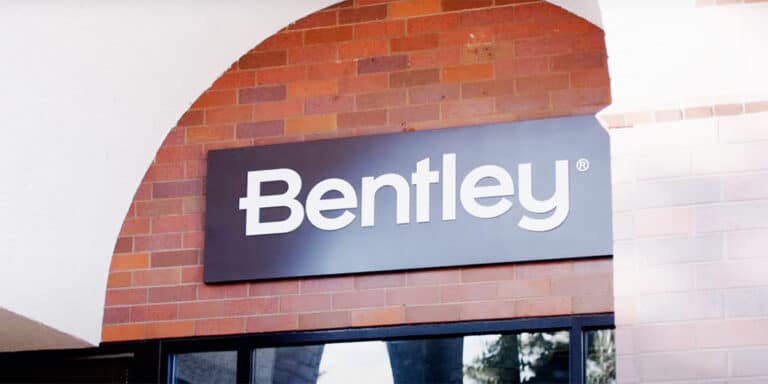If you haven’t heard the news yet, Bentley Systems has acquired Cesium, the foundational open platform for creating powerful 3D geospatial applications. The acquisition brings together the leading open platforms and developer communities for the built and natural environment.
However, this deal is about more than just capabilities; it’s about Bentley’s long-standing commitment to an open ecosystem and our long-term vision for serving the needs of infrastructure professionals.
Back in June, I had the privilege of speaking at the NXT.BLD and NXT.DEV conferences in London, which focus on the future of architecture, engineering, and construction (AEC) software. One of my key takeaways was that the transition is fully underway from file-based outputs to data-centric workflows. Software vendors, startups, and investors – and more importantly, infrastructure professionals – are discussing ways to unlock the data trapped in files through APIs. They want the data available to discover insights and efficiencies, apply artificial intelligence (AI), and perform other tasks. And while I was excited to engage in the discussion, I couldn’t help but urge attendees to consider the unintended results and outcomes that lay ahead.
The transition to a data-centric world has serious implications for everyone in the sector. Data about an infrastructure asset like a road or a bridge will have a similar lifespan as the infrastructure it describes. Selecting the right technical solution today to create, host, and leverage that data becomes a critical business decision. As the infrastructure sector rapidly moves to a data-centric world, how will infrastructure professionals avoid vendor lock-in, ensure interoperability, and prepare for future use cases and extensions?
The answer is true openness. Here’s what I mean.
Today, engineers have software tools that create and manipulate files on their workstations. They own the data because the files stay with them. But in most cases, the file format is binary and proprietary. The software tools that understand and use those files are also binary and proprietary.
 Engineers review a detailed 3D model of of a modern architectural structure displayed above them.
Engineers review a detailed 3D model of of a modern architectural structure displayed above them.A truly open approach, compatible with a world that is quickly moving to the cloud, must meet three requirements. First, the data is stored and represented using open standards. Second, open-source tools and libraries exist to work with that data. Third, APIs do more than query data: they extract it too. When these three criteria are met, if infrastructure organizations and professionals are unhappy with a software provider or need to use capabilities from another ecosystem, they can remove the data, understand how it’s structured, and leverage an existing technical foundation to keep things working. With applications and software tools based on proprietary formats, infrastructure organizations and professionals might not get that freedom.
An open approach has been a core principle of ours since the creation of the iTwin Platform, Bentley’s foundation platform for infrastructure digital twins. We believe that a platform and ecosystem based on openness is the best way to foster innovation and be a trusted partner to our users and accounts. That’s why we adopted existing standards like Cesium’s 3D Tiles to store and stream reality data. It’s also why we created new database technology and released it under open-source licenses to persist and collaborate on BIM data (Base Infrastructure Schema, iModel). Openness is why we created the technological building blocks to work with open data and released them under similar open-source licenses (iTwin.js on GitHub). And it’s why we’ve opened APIs in the iTwin Platform to allow our users to download the data to their local machine and work offline.
Other organizations share the same principles, ideas, and beliefs. Cesium is the most impressive company on that list.
For years, Cesium has been leading the charge in establishing and bolstering the adoption of open standards like 3D Tiles and glTF. Cesium’s runtimes are developed and released in the open using the same open-source licenses that Bentley uses. The numbers speak for themselves: Tens of thousands of developers use Cesium, and each month, 1 million active devices access Cesium ion, a SaaS platform for 3D geospatial data. Cesium.js, an open-source JavaScript library, has been used for countless use cases, from space exploration and deep-sea discovery to the recent 2024 Olympic Games in Paris. Talk about a thriving ecosystem built on openness.
Cesium’s success exemplifies the value of having an open approach. Bringing Cesium into Bentley is more than combining platforms and enhancing capabilities for developers and infrastructure professionals. It’s about bringing in a new team of colleagues and leadership to Bentley that shares similar values and a commitment to openness in the pursuit of doing the right thing for users.
 A wind turbine showing generation output and additional weather and performance statistics.
A wind turbine showing generation output and additional weather and performance statistics.With Cesium as part of Bentley, we will be able to double down on establishing, enriching, and maximizing the adoption of open standards for the built and natural environment.
I’ll end this by saying: This is just the beginning. And we’re looking forward to sharing exciting – and open – developments in the future.
Julien Moutte is the chief technology officer of Bentley Systems.:









